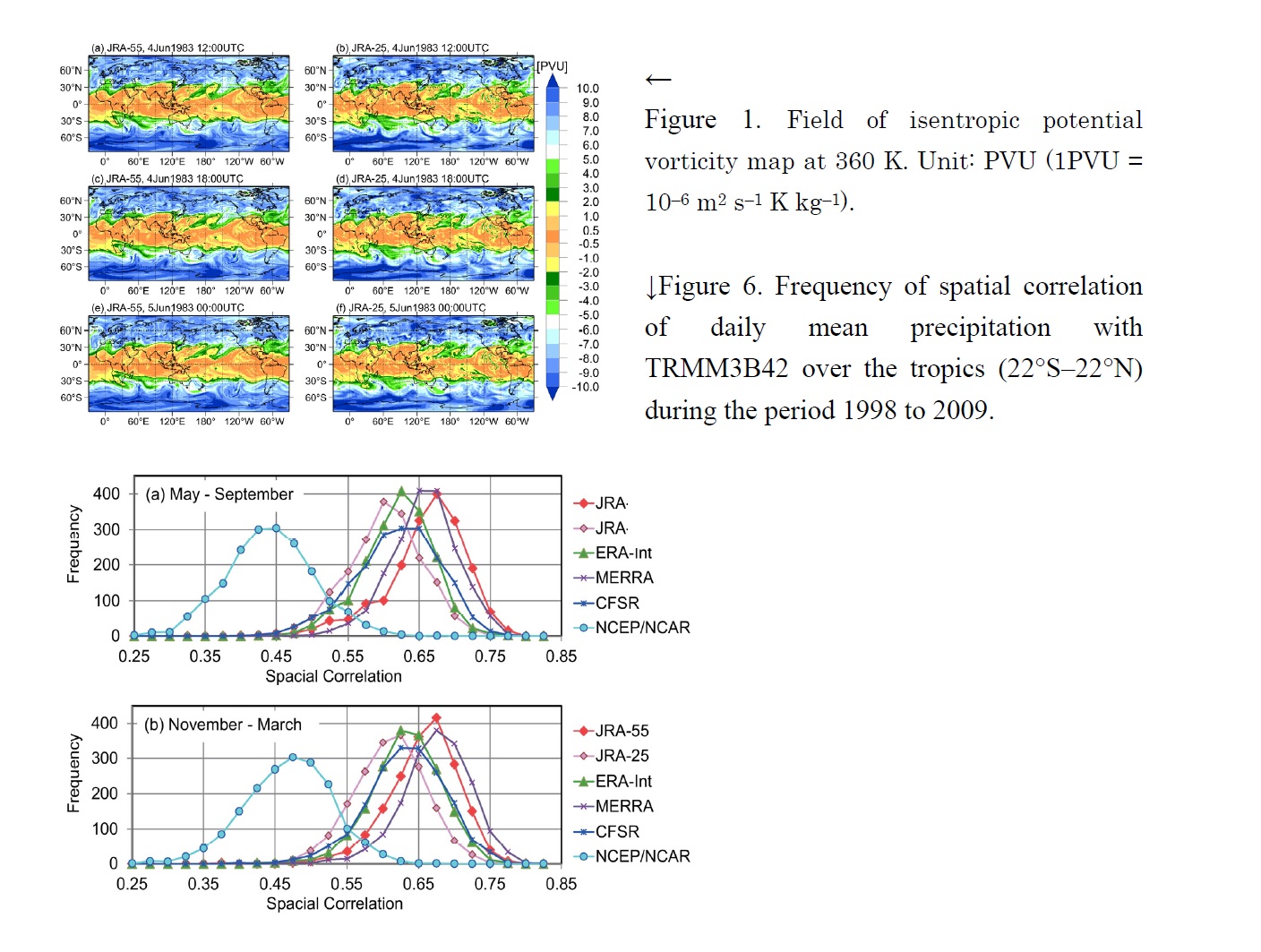Graphical Abstract
JMSJ, 2016, Vol. 94, No. 3 (June)
Articles
Tsuji et al. (2016)
Tsuji, H., H. Itoh, and K. Nakajima, 2016: Mechanism governing the size change of tropical cyclone-like vortices. J. Meteor. Soc. Japan, 94, 219-236.
https://doi.org/10.2151/jmsj.2016-012
Graphical Abstract
Highlights:
- We systematically perform numerical experiments using the primitive equation system on an f-plane. A simplified tropical cyclone-like vortex is initially given and an external forcing mimicking cumulus heating is applied in an annular region at a prescribed distance from the vortex center.
- The evolution of the vortex size defined by the radius of 15 m s-1 lowest level wind speed (R15) depends on the forcing location (Fig. 1).
- When forcing is applied near the center of the vortex where inertial stability is strong, R15 hardly changes. This is because the heat-induced secondary circulation is narrow, and the inflow near R15 is weak, so that little amount of AAM is carried inward (Fig. 2a).
- When forcing is located in a relatively outer region inside R15 where inertial stability is weak, R15 increases. The reason is that the secondary circulation is horizontally wide and strong inflow exists near R15, which causes strong inward AAM advection there (Fig. 2b).
- When the forcing location is outside R15, the vortex size decreases because the radial flow near R15 is outward, resulting in negative AAM advection (Fig. 2c).
Amemiya et al. (2016)
Amemiya, A., and K. Sato, 2016: A new gravity wave parameterization including three-dimensional propagation. J. Meteor. Soc. Japan, 94, 237-256.
https://doi.org/10.2151/jmsj.2016-013
Graphical Abstract
Highlights:
- We developed a new orographic gravity wave parameterization(GWP) scheme, in which
- Location and local wavenumbers of steady GW packets are calculated by integrating the ray tracing equations in the vertical.
- GW forcing is calculated as the convergence of pseudomomentum flux, which includes the forcing due to horizontal refraction.
- Horizontal inhomogeneity is approximated using Taylor series expansion, so that the calculation can be performed exclusively in each vertical column under the parallelization.
- We performed a pair of numerical experiments using the high-top version of MIROC-AGCM for 50 years, with the new GWP scheme (OGW3D) and the conventional scheme (CONTROL), respectively. Compared with CONTROL, in OGW3D simulated climatological GW forcing in the SH winter is expanded in horizontal (Fig. 1) and the well-known gap at 60°S is alleviated (Fig. 2). The climatological polar night jet seems not much influenced, suggesting the contribution of zonally asymmetric response like the enhancement of planetary waves.
Ichikawa et al. (2016)
Ichikawa, Y., and M. Inatsu, 2016: Methods to evaluate prediction skill in the Madden-Julian oscillation phase space. J. Meteor. Soc. Japan, 94, 257-267.
https://doi.org/10.2151/jmsj.2016-014
Graphical Abstract
Highlights:
- Indices of prediction skill over the Madden-Julian oscillation (MJO) phase space are examined with reanalysis and forecast data provided by the Japan Meteorological Agency (JMA). Conventionally, the root-mean-square error (RMSE) and anomaly correlation coefficient (ACC) have been used, although this approach misses information on the model bias for MJO events. Moreover, the ACC is not suitable for models in which the MJO signal tends to damp in some phases, because the ACC strongly depends on the MJO amplitude. As is shown above, both ACC (Fig. 1a) and RMSE (Fig. 1b) indicate a better skill in Phases 4-5 and a worse skill in Phases 8 and 1. The ACC is rather axisymmetric around the origin, so that this index unintendedly shows a bad skill solely with small MJO amplitude. The RMSE, in contrast, is obviously asymmetry. This discrepancy between ACC and RMSE is a problem when one evaluates the MJO forecast. The mean-error vector (Fig. 1c) compensates this drawback by associating a model’s erroneous mean tendency with RMSE. The leftward mean error vector field uniformly distributed over the MJO phase space with its amplitude related to RMSE. We recommend that the mean error vector together with RMSE should be used for evaluating MJO prediction skill.
Harada et al. (2016)
Harada, Y., H. Kamahori, C. Kobayashi, H. Endo, S. Kobayashi, Y. Ota, H. Onoda, K. Onogi, K. Miyaoka, and K. Takahashi, 2016: The JRA-55 Reanalysis: Representation of atmospheric
circulation and climate variability. J. Meteor. Soc. Japan, 94, 269-302.
https://doi.org/10.2151/jmsj.2016-015
Graphical Abstract
Highlights:
- Improvements were found in the representation of atmospheric circulation on the isentropic surface (Fig. 1) and in the consistency of momentum budget based on the mass-weighted isentropic zonal mean (MIM) method.
- In the tropics, the frequencies of high spatial correlations with precipitation estimated using Tropical Rainfall Measuring Mission (TRMM) Multisatellite Precipitation Analysis (TMPA) are clearly higher in JRA-55 than in JRA-25 (Fig. 6).
- The results indicate that JRA-55 generally improved the representation of phenomena on a wide range of space–time scales, such as equatorial waves, and transient eddies in the storm track regions, compared with JRA-25 during the satellite era, and improved the temporal consistency compared with the older reanalyses throughout the reanalysis period.
Qian et al. (2016)
Qian, W.-H., J. Huang, and G.-W. Zhang, 2016: Reexamining the binary interaction of four pairs of tropical cyclones in the Northwest Pacific. J. Meteor. Soc. Japan, 94, 303-322.
https://doi.org/10.2151/jmsj.2016-016
Graphical Abstract
Highlights:
- Four pairs of tropical cyclones (TCs) in the vicinity of Northwest (NW) Pacific have been restudied in this paper by decomposing a total flow into a climatic component and an anomaly (Figure 1) as well as by a simple generalized beta-advection model (GBAM). Results contradict with previous identification that binary interactions occurred in the four pairs of TCs (Figure 2).
- The intensities of the four studied TC pairs were not well equal to each other at the same time during their common lifetime period. The result of GBAM revealed that a stronger TC had a direct influence on the track of a weaker TC but the reverse was not true.
- Whether a binary interaction happens between two TCs and whether the two TCs interact with other anomalous systems can be determined by the GBAM at the optimal level near the maximum center of vorticity anomaly.











